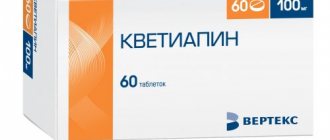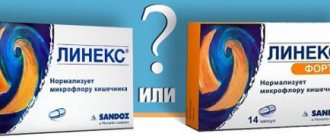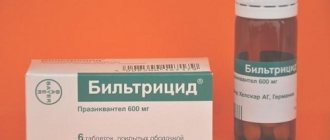Kaletra
St. John's wort (Hypericum perforatum), rifampicin reduces the concentration of the drug in plasma, which can lead to a decrease in the therapeutic effect and the development of resistance.
Lopinavir and ritonavir inhibit the CYP3A isoenzyme in vitro. The simultaneous administration of the drug and drugs that are primarily metabolized by the CYP3A system can increase or prolong their therapeutic effect and side effects: astemizole, terfenadine, midazolam, triazolam, cisapride, pimozide, amiodarone, ergot alkaloids - ergotamine and dihydroergotamine, ergometrine and methylergometrine.
The drug also inhibits CYP2D6 in vitro, but to a lesser extent than CYP3A. The clinical significance of this phenomenon is unknown. Until more detailed information is available, it should not be used concomitantly with drugs whose metabolism depends on the activity of CYP2D6 (for example, propafenone), and an increase in plasma concentrations of which can lead to serious or life-threatening side effects.
At concentrations used in clinical settings, does not inhibit CYP2C9, CYP2C19, CYP2E1, CYP2B6, or CYP1A2.
Didanosine should be taken 1 hour before or 2 hours after taking Kaletra (gastric juice-resistant dosage forms of didanosine should be taken 2 hours after meals).
Kaletra reduces plasma concentrations of zidovudine and abacavir.
The results of a study in HIV-positive children revealed a decrease in the concentration of lopinavir when administered simultaneously with nevirapine. The effects of nevirapine in HIV-positive adults are likely to be similar to those in HIV-infected children (resulting in decreased lopinavir concentrations).
Kaletra increases plasma concentrations of the HIV protease inhibitors indinavir, nelfinavir and saquinavir. When taken simultaneously with the drug at a dose of 400 mg + 100 mg 2 times a day, indinavir at a dose of 600 mg 2 times a day and saquinavir 800 mg 2 times a day, there are no changes in AUC and the Cmin of indinavir and saquinavir increases compared to traditional treatment regimens . When taken simultaneously with an additional 100 mg of ritonavir 2 times a day, the AUC of lopinavir increased by 33% and Cmin by 64% compared with taking the drug at a dose of 400/100 mg (3 capsules) 2 times a day. The optimal doses of HIV protease inhibitors when prescribed in combination with Kaletra have not yet been established in terms of efficacy and safety.
Antiarrhythmic drugs (bepridil, lidocaine and quinidine): the concentrations of these drugs may increase when administered simultaneously with Kaletra (care should be taken and, if possible, their plasma concentrations should be monitored).
Warfarin concentrations may change when administered concomitantly (monitoring of blood coagulation parameters is recommended).
Antiepileptic drugs (phenobarbital, phenytoin, carbamazepine) reduce the concentration of lopinavir.
Increases concentrations of BMCC (felodipine, nifedipine, nicardipine) in plasma.
HMG-CoA reductase inhibitors (lovastatin and simvastatin) are significantly metabolized by CYP3A4, and when administered concomitantly, their plasma concentrations may increase significantly (risk of myopathy and rhabdomyolysis). The combined use of these drugs is not recommended. Atorvastatin and cerivastatin are metabolized to a lesser extent by CYP3A4. When co-administered with atorvastatin, an increase in Cmax and AUC was observed by an average of 4.7 and 5.9%. When administered concomitantly, the lowest effective doses of atorvastatin and cerivastatin should be used. In cases where treatment with HMG-CoA reductase inhibitors is indicated, it is recommended to use pravastatin or fluvastatin (their metabolism does not depend on CYP3A4).
Dexamethasone may induce CYP3A4 and reduce lopinavir blood concentrations.
The AUC of sildenafil after a single dose of 100 mg against the background of regular administration of ritonavir at a dose of 500 mg 2 times a day is 1000% greater than without ritonavir (simultaneous use of the drug with sildenafil is not recommended, and the dose of sildenafil should not exceed 25 mg per 48 h).
May increase the concentration of cyclosporine and tacrolimus in the blood (more frequent determination of the therapeutic concentration of these drugs is recommended until a stable state is established).
Plasma concentrations of ketoconazole and itraconazole may increase (doses greater than 200 mg/day are not recommended).
Moderately increases the AUC of clarithromycin, therefore, in patients with renal/hepatic insufficiency, a reduction in the dose of clarithromycin is necessary.
Oral contraceptives: Because ethinyl estradiol concentrations may decrease, alternative or additional methods of contraception should be used.
When co-administered with rifabutin for 10 days, the Cmax and AUC of rifabutin increased by 3.5 and 5.7 times, respectively (parent drug and active 25-O-desacetyl metabolite), a 75% dose reduction of rifabutin is recommended (further dose reduction of rifabutin may be necessary).
It is possible to increase the concentration of drugs that cause prolongation of the QT interval (chlorphenamine, quinidine, erythromycin, clarithromycin), which increases the risk of developing rhythm disturbances.
Similar drugs:
- Ergoferon () Lozenges
- Groprinosin Oral tablets
- Groprinosin Oral tablets
- Tea tree DN Ointment for external use
- Valtrex Oral tablets
- Zanamivir Powder for inhalation, dosed
- Valacyclovir Oral tablets
- Oseltamivir Capsule
- Anaferon for children (Anaferon filios) Lozenges
- Laripront Lozenges
** The Drug Directory is intended for informational purposes only. For more complete information, please refer to the manufacturer's instructions. Do not self-medicate; Before you start using Kaletra, you should consult your doctor. EUROLAB is not responsible for the consequences caused by the use of information posted on the portal. Any information on the site does not replace medical advice and cannot serve as a guarantee of the positive effect of the drug.
Are you interested in Kaletra? Do you want to know more detailed information or do you need a doctor's examination? Or do you need an inspection? You can make an appointment with a doctor - the Euro lab is always at your service! The best doctors will examine you, advise you, provide the necessary assistance and make a diagnosis. You can also call a doctor at home . Euro lab clinic is open for you around the clock.
** Attention! The information presented in this medication guide is intended for medical professionals and should not be used as a basis for self-medication. The description of the drug Kaletra is provided for informational purposes only and is not intended for prescribing treatment without the participation of a doctor. Patients need to consult a specialist!
If you are interested in any other drugs and medications, their descriptions and instructions for use, information about the composition and form of release, indications for use and side effects, methods of use, prices and reviews of drugs, or you have any other questions and suggestions - write to us, we will definitely try to help you.
Side effects
When treated with Kaletra, a deterioration in well-being is possible, which manifests itself in the form of individual hypersensitivity of the body. In addition, multiple reactions from various internal systems and organs cannot be ruled out.
Digestive system:
- Diarrhea
- Irregular bowel movements, fecal incontinence
- Nausea, vomiting
- Flatulence, bloating
- Stomach ache
- GERD, gastritis
- Dry mouth, ulcers
- Periodontitis
- Belching
- Stomatitis.
CNS:
- Head pain
- Sleep disturbance, insomnia
- Decreased sex drive
- Depressive states
- Increased nervousness, irritability
- Drowsiness
- Change in taste sensations
- Blackout
- Sudden change of mood
- Disorientation
- Cognitive impairment
- Memory losses
- Migraine
- Trembling limbs
- Apathy
- Cramps.
SSS:
- Deterioration of vascular condition
- Increase in blood pressure
- AV block
- Increased heart rate
- Angina pectoris
- Myocardial infarction
- Thrombosis
- Phlebeurysm
- Orthostatic hypotension.
Leather:
- Pathology of adipose tissue (lipodystrophy)
- Rashes, acne
- Hair loss
- Dermatitis
- Changing the nail structure
- Itching
- Dry dermis, eczema
- Swelling of the face
- Ulcers
- Band-like skin atrophy (“stretch marks”).
KMS:
- Myalgia
- Pain in the lower back, joints
- Osteoarthritis
- Muscle weakness.
Metabolism:
- Dehydration
- Obesity or sudden weight loss
- Decreased or increased appetite
- Hypovitaminosis
- Decreased production of thyroid hormones (hypothyroidism)
- Lactic acidosis
- Lipomatosis.
Endocrine and urinary systems:
- Diabetes
- Increased blood content in urine
- Kidney stone formation
- Deviation from normal urine parameters, change in its smell.
Reproductive system:
- erectile disfunction
- Painful periods
- Enlargement of the mammary glands.
Respiratory system:
- Bronchitis
- Cough
- Labored breathing
- Pulmonary edema
- Bronchial spasms.
Hematopoietic organs: anemia, decreased formation of leukocytes.
Sense organs: dizziness, blurred vision, tinnitus, imbalance.
Other adverse reactions:
- Lethargy, weakness
- Accession of infection
- Furunculosis
- Feverish conditions
- Swelling
- Neoplasms
- Chest pain.
In children, the symptoms of side effects are generally similar to those in adults, but the most common symptoms include rashes, vomiting, diarrhea, dryness of the dermis or oral mucosa, and distortion of taste. It is also possible that the composition of the blood changes, the development of infectious diseases, and febrile conditions.
Overdose
To date, there is scant data on the features of the development of an overdose of Kaletra.
When using a medication, it must be taken into account that a special antidote has not yet been developed that would stop the negative symptoms. Therefore, in the event of the development of intoxication, the specifics of treatment are determined by the symptoms that appear. Therapy should be aimed at maintaining the body, ensuring the functioning of internal systems, and constantly monitoring the patient’s condition. If possible, it is necessary to remove the drug from the body by gastric lavage and give activated charcoal.
There is more specific data on the development of overdose after consuming overdoses of Kaletra in the form of a solution. Thus, in children born prematurely, it was recorded:
- Complete AV block (impaired heart rhythm or blood flow through the vessels)
- Cardiomyopathy (damage to the heart muscle)
- Lactic acidosis
- Acute renal failure.
In addition, due to the ethanol content in the solution, the development of alcohol intoxication is possible if the drug was drunk in large quantities. To eliminate an overdose, the same measures are used as for poisoning with tablets or capsules. But if in their case dialysis is ineffective, then in case of poisoning with the solution it is used to eliminate the effects of alcohol and propylene glycol.
Analogs
Today, there are many medications to combat HIV infection. Each of them has its own specific effect and has side effects and contraindications. Therefore, only a specialist can say right away what will work better - Kaletra or Reyataz, or Lamivudine, Nikavir, Regast, Disaverox, etc. - after a detailed analysis of the patient’s condition.
Regast
"Pharmasintez" (RF)
Cost: 100 mg (30 pcs.) – 798 rub.
A medication with an antiviral effect, developed for use in the treatment of HIV-1 as an additional agent. Not used for monotherapy, otherwise addiction may develop.
The therapeutic effect is achieved thanks to the active component – efavirenz. The substance belongs to the group of NNRTIs (non-nucleoside reverse transcriptase inhibitors).
After penetration into the body, it suppresses the virus in the early stages of its development, promotes the production of immune bodies, and inhibits the progression of the disease. Therefore, Regast copes well with acute infections.
The drug is indicated for therapy starting from 3 years of age, provided that the patient’s weight is at least 13 kg. Due to the lack of data on the effect on the fetus, Regast is not recommended for pregnant women. It is also contraindicated during lactation.
The product is produced in tablet form - pills of a golden or brownish hue. Several types of tablets are available with different contents of the main component: 100, 300, 400, 600 mg.
Contraindications to the use of Regast are individual reactions of the body to the constituent substances, gestational period, breastfeeding, and childhood.
The dosage and duration of administration are determined by doctors individually for each patient.
Pros:
- Strong action.
Flaws:
- Mental disorders and suicidal intentions are possible.
Release forms
The drug is presented in several forms:
Cost: (120 pcs.) – 5258 rub.
Tablets (200/50) – red, oval-shaped pills. Enclosed in a film coating. There is an embossed logo on one of the surfaces. Tablets are packaged in 60 or 120 pieces in dense polymer jars. The cardboard package contains one can and instructions for use.
Average price: (60 pcs.) – 4817 rub.
Tablets (100/25) – oval-shaped pills in a pinkish film coating. On one surface there is an engraved Abbott manufacturer logo and the abbreviation AC. The tablets are packaged in 60 pieces in dense polyethylene jars, enclosed in cardboard packaging with an annotation.
Price in online pharmacies: from 5,000 rubles.
Capsules are soft pills in an orange gelatin body. The logo and abbreviation RK are printed on the surface in black. Capsules are filled with a clear solution. The pills are packaged in plastic jars of 90 pieces or in blisters of 6, which are packed in boxes. In a cardboard package with an annotation - 2 cans or 5 boxes, each of which contains 6 records.
Average cost: 7457 rub.
Oral solution – pale yellow or yellow liquid, without suspensions. Packaged in 60 ml plastic bottles with a dosing device. In a cardboard package - one bottle, annotation.









